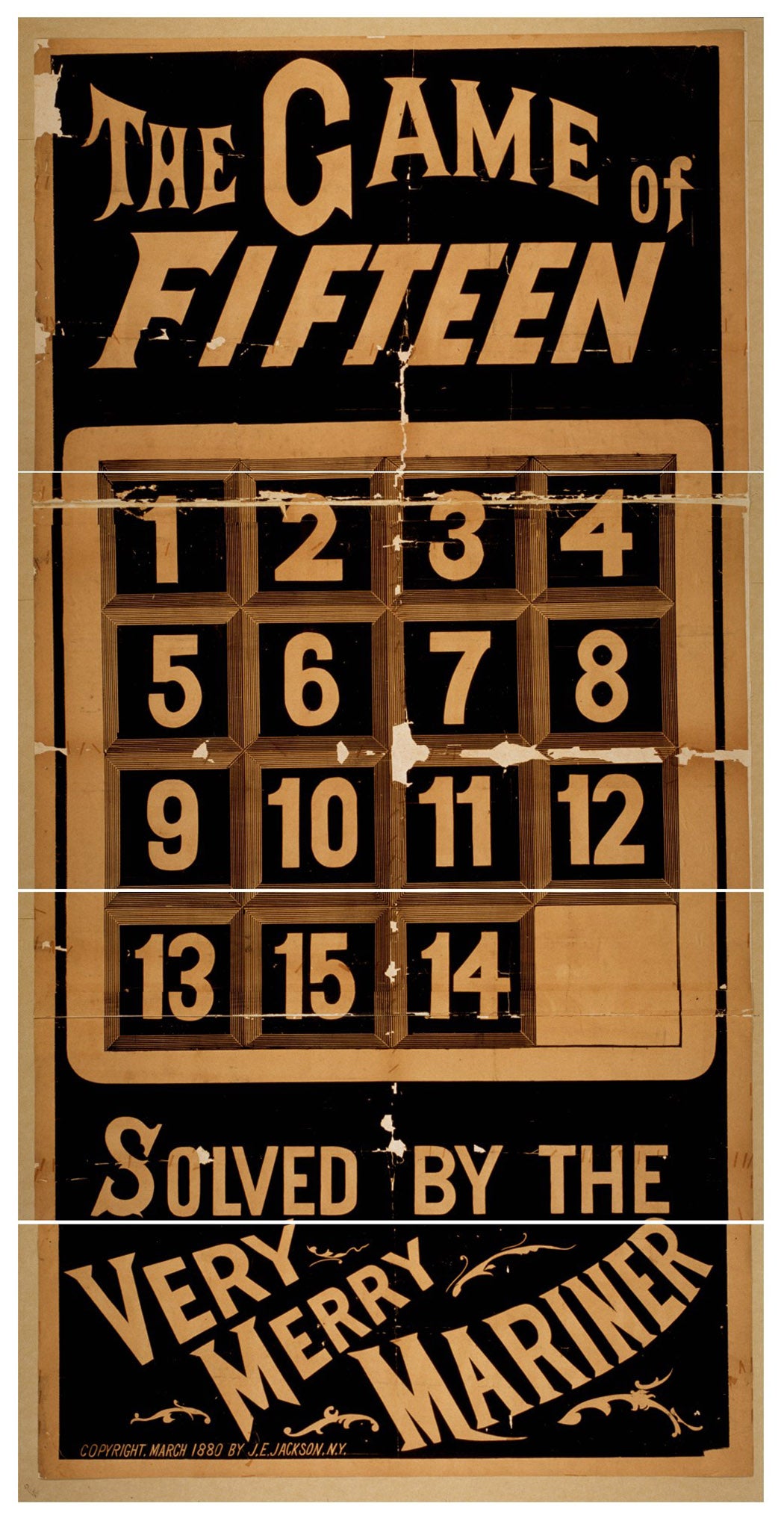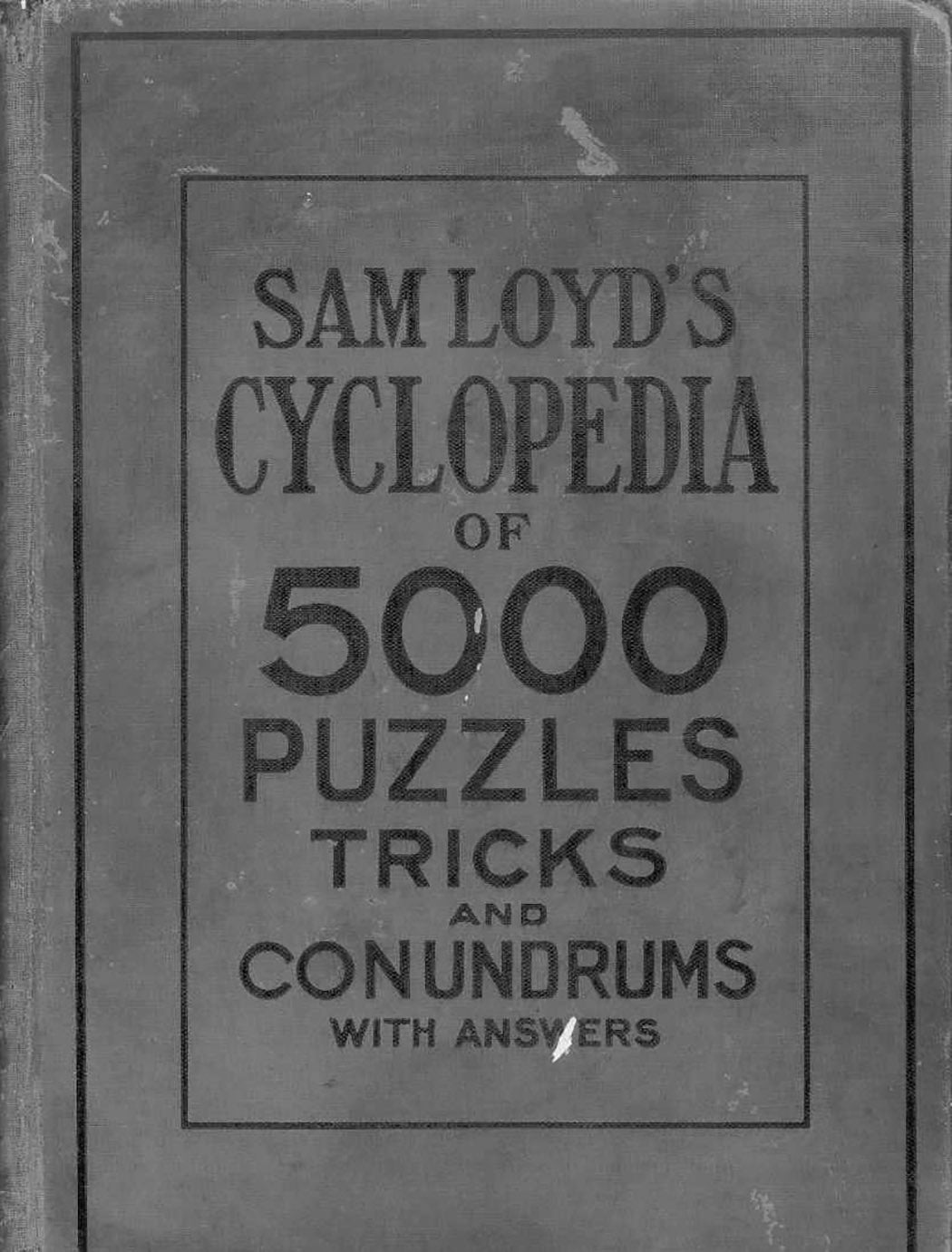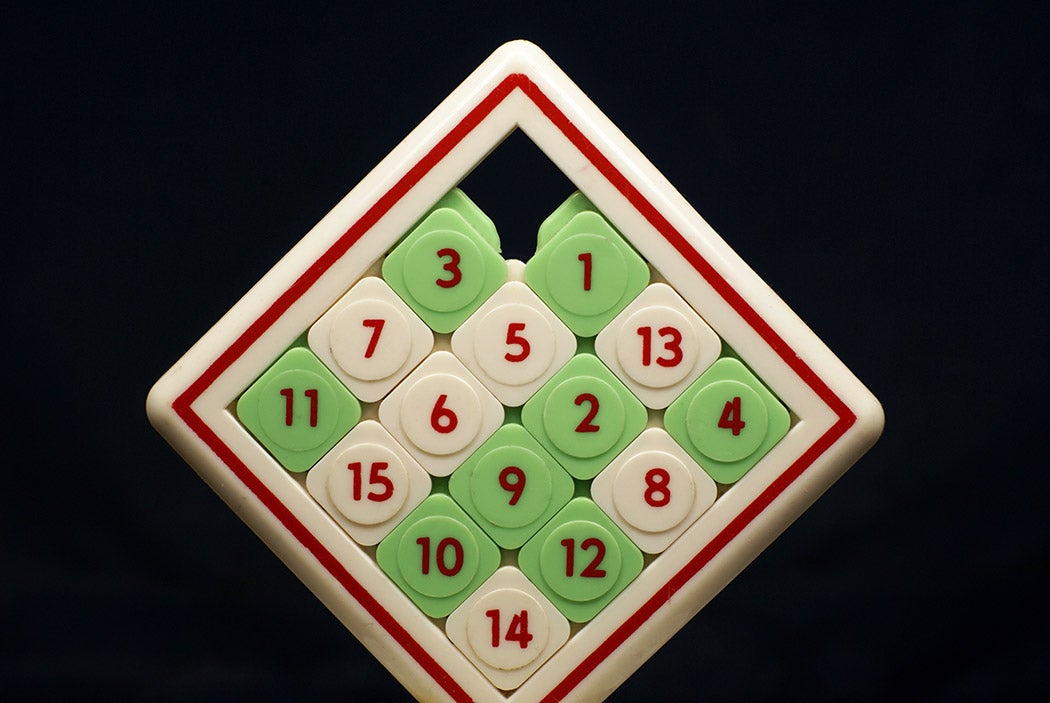It’s January, and a new grid-based puzzle has emerged onto the games-playing scene. The directions couldn’t be simpler: rearrange squares in a special way to arrive at the solution. On the surface, nothing marks this game as particularly addictive. But in just a few months’ time, the puzzle has ballooned into a bona fide craze, sparking letters to editors, advertisements, myriad frustrated solvers’ comments, even poetry. Office workers can’t focus, neglecting their responsibilities. College students ignore classes and let their personal hygiene go. Marriages dissolve as partners get so lost in rearrangement that they forget other duties.
The year is 1880. The game in question is the Fifteen Puzzle.
The Fifteen Puzzle, as New York Times crossword editor and puzzle guru Will Shortz has observed, was the first in the modern era to inspire crazes: the precursor to the crossword, the Rubik’s Cube, and, most recently, Wordle.
Weekly Newsletter
Also called the Gem Puzzle, the Boss Puzzle, the Game of Fifteen, or the Magic Square, among other monikers, the Fifteen Puzzle is a mechanical game. Fifteen numbered blocks get placed any order in a shallow four-by-four box. The container is big enough to hold sixteen such squares, leaving one position perpetually empty. Then, the player slides the numbers around, shifting them in and out of the blank space, in an attempt to move them into order, and leaving the empty slot in the bottom right corner.

Although players can start with the numbered pieces in any combination, the version of the puzzle that quickly became the most popular is also one of its most maddening iterations. The puzzle kicks off with the squares in their natural order, except for the last two. That is, the final row reads 13, 15, 14, blank space, and players must find a way to reverse those last two numbers.
The game seems simple enough, but solvers soon realized it was hardly as easy as it appeared to be. Puzzle experts Jerry Slocum and Dic Sonneveld have charted the story behind this phenomenon in meticulous detail. “The major factor in the fascination with the puzzle from the beginning was that sometimes the puzzle, although a bit difficult, could be solved,” they write in The Fifteen Puzzle. “At other times no solution could be found, no matter how long or hard one tried.” That’s because the Fifteen Puzzle taps into a central binary phenomenon of computational algebra: about 50 percent of the time, the game is easy, and the other 50 percent, it is impossible. And the 13-15-14 starting position is one of these impossibilities.

In 1879, as the Fifteen Puzzle was exploding in popularity, the American Journal of Mathematics published a pair of articles parsing it. W.W. Johnson explained that any odd permutation—that is, one where the end placement requires an odd number of moves from the original setup—is impossible to achieve. Meanwhile, W.E. Story demonstrated that any even permutation is possible. Anticipating reader uproar over dedicating so much space to a game, the Journal’s editors explained in their pages that they were not doing so in response to the puzzle’s popularity but because “the principle of the game has its root in what all mathematicians of the present day are aware constitutes the most subtle and characteristic conception of modern algebra, viz: the law of dichotomy applicable to the separation of the terms of every complete system of permutations into two natural and indefeasible groups.”
The Fifteen Puzzle has had a long and lively afterlife as the subject of mathematical scrutiny. Both pedagogical and technical journals have proffered various ways to approach it. In 1879, for example, mathematician Wm. Woolsey Johnson rounded up several successful strategies, documenting various ways to get the 13, 14, and 15 to line up in the correct order by rotating the box a quarter-turn.
Indeed, the Fifteen Puzzle is a useful tool for solving other math conundra. A knight’s tour in chess is a series of moves such that a knight visits each square exactly once. The knight’s tour problem—that is, the mathematical game of finding a knight’s tour, often on a different kind of board than a typical 8×8 board—is a common exercise, especially for computer scientists. You can’t complete a full knight’s tour on a 4×4 square: you can only touch fifteen of the sixteen squares once. Using a kind of remix logic, scholars Spencer Hurd and David Trautman revisited the Fifteen Puzzle through the mechanism of the knight’s tour, calculating how many legal tours there were on the board (sixty, with 160 mirrored “illegal twin” tours). Through this ingenious methodology, the proof provides a clever visualization that both helps explain, through this new methodology, why you can never transpose 13-15-14 back to its original state—and why we might care in the first place.
* * *
Early copies of the Fifteen Puzzle started selling in Boston in December 1879. By the following January, toy manufacturers across the United States had begun producing their own versions. Players needed a physical copy of the game to play, but newspapers were crucial to spreading the craze. They printed grid challenges and asked readers to send in solutions, offering prizes as incentives.
In January 1880, Charles Pevey, a dentist in central Massachusetts, offered readers of the Worcester Evening Gazette a twenty-five dollar set of teeth as reward for solving the 14-15 transposition problem. Pevey bought another ad in the Worcester Spy, upping the ante to a hundred dollars cash, plus a set of chompers.
In March, 1880 the Syracuse Sunday Times waxed poetic on the woes of playing the game:
With tearful eyes and angry mien—
With wasted form so thin and lean—
With hectic flush that’s never seen,
Except on one who long has been
Devoid of happiness serene—
A box lay near her, (white and green,)
Quite full of blocks; one space between.
“Say, Maiden, say, what does it mean?”
“I’m working at the ‘Gem Fifteen!’”
Games can be love stories—software engineer Josh Wardle invented Wordle to amuse his partner; the New York Times has published crosswords that do double duty as marriage proposals. But the Fifteen Puzzle was notorious for tearing couples asunder rather than uniting them. To with, an 1880 poem in the New York Mail:
William goes a-courtin’
With her silent sits.
Both engaged in sortin’
Wooed in little bits.
Not a word they utter–
Cur’ous kind o’ courtin’
Now and then they mutter:
“Thirteen-fifteen-fourteen.”
By March 22, 1880, the New York Times reported, “No pestilence has ever visited this or any other country which has spread with the awful celerity of what is popularly called the ‘Fifteen Puzzle.’ It is only a few months ago that it made its appearance in Boston, and it has now spread over the entire country. Nothing arrests it. Neither age nor sex is spared by it, and it now threatens our free institutions, inasmuch as from every town and hamlet there is coming up a cry for a ‘strong man’ who will stamp out this terrible puzzle at any cost of Constitution or freedom.”

Such apocalyptic hullabaloo foreshadows backlash against the crossword. The 1924 publication of Simon and Schuster’s The Cross Word Puzzle Book ushered in a bona fide new craze. “Puzzles of 1925,” a Broadway musical, featured a scene set in a crossword sanitorium, with solvers who have lost their minds. In November 1924, humorist Gelett Burgess re-wrote his famous light verse, “The Purple Cow,” in a cruciverbal vein:
The fans they chew their pencils
The fans they beat their wives
They look up words for extinct birds
They lead such puzzling lives.
Crosswords, sniffed the New York Times, were basically responsible for everything wrong with American readers. Eventually, however, in one of its most lucrative about-faces, the Times finally caved. In 1942, the Times introduced its now legendary puzzle, which has gone on to earn the paper millions in revenue and lure millions of subscribers.
* * *
Most of the games that have generated modern-day crazes have straightforward, often adorable, origin stories. The crossword puzzle was born out of necessity on December 21, 1913. Arthur Wynne, editor of the New York World’s “FUN” section, needed to fill a jumbo-sized holiday supplement, so he printed a blank grid with clues next to it. He dubbed the grid, which looked like a diamond-shaped donut, “FUN’s Word-Cross Puzzle.” Readers clamored for more; by 1914, the donut had rotated to a square, the title was transposed, and the “Cross-Word” (soon, “crossword”) became the grid we love today. In November 2021, Josh Wardle unleashed Wordle on the world; two months later, the New York Times paid him more than seven figures to buy it.
The enigma that still haunts the Fifteen Puzzle, however, is who actually invented it. In 1880, Matthias Rice, a Boston-based woodworker, claimed to have first produced it after a mysterious man at his window presented him with a crude mock-up of the puzzle. As Rice told the Boston Herald, the game had been invented in Hartford by a group of deaf students, who took it to Boston to sell it. Rice, a recent invalid who needed a side project for his studio to make extra cash, started producing the board in much higher quality and in much greater quantities than the students’ homemade efforts. Demand outpaced supply, and copycat versions mushroomed overnight. Entrepreneurs across the country soon began importing the puzzle or making their own versions, and varieties proliferated so fast no one could keep track of them.

Yet Rice’s claim over the puzzle soon faded from public imagination. Starting in 1891, and for more than a hundred years, web sites, encyclopedias, articles, and books nearly unanimously assigned credit for the puzzle to Sam Loyd, who rose to prominence as a prodigal chess player and author of popular chess problems before branching into myriad other types of number and word games. Puzzlers clamored for his witty inventions, and Loyd’s mathematical ingenuities became distributed far and wide by entities as disparate as P.T. Barnum and the Metropolitan Life Insurance Company. He had regular columns in magazines and thousands of devoted readers. The Strand, a popular British periodical famous for dropping exclusive new adventures of detective Sherlock Holmes, dubbed Loyd the “prince of puzzles.”
Celebrated though he was for making puzzles, Loyd was infamous for other reasons. A longtime collaborator accused him of plagiarism, and his puzzles took an approach to race—especially toward people who hailed from China—which readers today find cavalier, if not downright racist.
Loyd never affirmatively stated that he invented the Fifteen Puzzle, but he also never denied rumors to that effect. Indeed, once people started attributing the puzzle to him, he embraced this claim, and folded “Inventor of the Fifteen Puzzle” into his biography. This assertion was accepted as fact throughout the twentieth century. The venerated recreational mathematics author Martin Gardner, helped cement the lie by repeating it in his books on puzzles. Journals and teaching tools that example the mathematical angles of the Fifteen Puzzle all credited Loyd, as well.
Yet, Loyd couldn’t have invented the Fifteen Puzzle. First of all, he didn’t even take credit for its existence until 1891, a full decade after the massive craze had already swept the country. According to the publication of newspaper advertisements and articles, the Fifteen Puzzle—at least, in its most popular form—originated in the Boston area, where the earliest news items and ads for the game appear, in late 1879. From there, as Slocum and Sonnenveld track, the game spread to Worcester, Rochester, New York, Washington, and beyond. At the time, Loyd was immersed in chess: he was Problem Editor for the American Chess Journal and wrote a chess column for Scientific American. He also published a book on chess strategies that came out right around 1880. If Loyd was also manufacturing virally popular puzzle boxes on the side, he remained silent about it––and radio silence was hardly his style.
In fact, Slocum and Sonneveld trace the origins of the Fifteen Puzzle to one Noyes Chapman, a postmaster in upstate New York, who gave homemade versions of this toy to friends and family. Chapman’s son gave a copy to a couple in Rhode Island; it got passed along to friends in Hartford, Connecticut, where a duplicate landed in the hands of a student at the American School for the Deaf. At the time, students at the school frequently manufactured and sold small objects for pocket money, which is how Rice, the Boston woodworker, discovered the game in 1880. Because there’s no one solution to the game, it could not, at that time have been patented, though Slocum and Sonneveld point out that Chapman did in fact try to. Ironically, the very mechanism that made the Fifteen Puzzle impossible to solve half the time, the slight difference he wanted to patent in his sliding block puzzle, was what led to the game’s outrageous success.
Like the crossword, or the Rubik’s Cube, or Wordle, the Fifteen Puzzle caught hold of the public imagination through some mysterious amalgam of simplicity and complication, with a bit of luck and serendipity throw in as well. It taps into the same psychological lure as Schrödinger’s Cat: begin the Fifteen Puzzle, and enjoy a fifty percent chance of easy success, and another fifty you won’t ever solve it.
The Fifteen Game hinges, ultimately, on eternal hope, even as you know you’re doomed: transposing numbers seems in reach. It’s the math that begs to differ.
Support JSTOR Daily! Join our new membership program on Patreon today.







